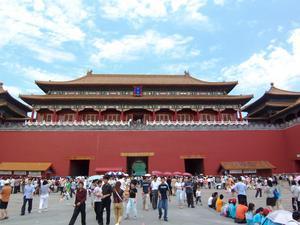Advertisement
Published: August 13th 2006

 Meridian Gate
Meridian Gate
From its podiums, the emperor would review his armies and perform ceremonies marking the start of the new calendar.Beyond the Tiananmen Gate, in the heart of Beijing, having passed under the portrait of Chairman Mao, lies the Forbidden City. This was the imperial heart and soul of the Chinese civilization. Between 1420 and 1911 it was the residence and the court of the Ming Dynasty and the Qing Dynasty, and is the largest palace complex in the world. There are 9,999 rooms throughout this "hidden city". 10,000 rooms would have been exaggerated pride, since heaven is reputed to have 10,000 rooms, and the emperors didn't want to tempt fate. Besides, the number 9 is an especially fortunate number. The doors used by the emperor usually have 81 very large brass studs. (9 x 9 = 81) :-)
A massive gate, called the Meridian Gate refused entrance to all but the most privileged. For others, its imposing size would have made it impossible to enter; those more daring would have to deal with the lethal royal guard. It was only fully opened to the public in 1949.
The construction of the Forbidden City, now a spectacular World Heritage Site, required more than 100,000 skilled craftsmen and artisans and more than one million very tired and overworked laborers (forget
about minimum-wage). It is estimated, that some 12,000 visitors now admire this cultural gem of China every day.
Ordinary Chinese citizens were barred from setting foot inside the palace grounds, and were executed if they did.
But at the hight of the Ming Dynasty, some 100,000 young and old eunichs (castrated men) served their emperor and their empress behind the gates. That alone speaks for the size of this palace-lay-out.
The complex is literally a city within a city, huge and impossible to cover in just one or two days. Walking along the many streets and hide-aways, it is easy to imagine these mighty Heads of State, and all of their court intrigues, often written and spoken about in legends, even today.
Having made it safely through the portals of the Meridian Gate, 5 marble bridges point the way over a canal, the center bridge only to be used by the emperor. The Gate of Supreme Harmony then unlocks the view toward the elevated and largest of the Palace Halls, known as the Hall of Supreme Harmony, in which the ornate throne still sits beneath a fabulously colored ceiling.
The main buildings of the Forbidden City

 Supreme Harmony
Supreme Harmony
Close up of left side of Gate of Supreme Harmony.are geometrically laid out on a North to South axis, and we entered from the South, through the Hall of Supreme Harmony (already mentioned), past the Hall of Middle Harmony, where the emperor waited for official ceremonies. Beyond lies the Hall of Preserving Harmony. These are the official buildings of the front of the palace, and are of spectacular size and beauty and of course, "Harmony".
It is worth noting, that everytime "Gate" is mentioned, that "Gate" becomes the portal of an additional high-wall, and further filtered the ranks of the palace-elite from each other, and of course to protect the next group of structures. Behind each new wall the Royal Family escaped deeper into insulation from the pain and suffering on the outside.
Historically, a whole series of WALLS "seemingly" provided safety and comfort for those who ruled this mighty empire:
a. From the furthest Great-WALLS protecting China's frontiers,
b. to the Great-WALLS on the mountain-cliffs surrounding greater Beijing,
c. to the spectacular WALLS that once surrounded the thriving city itself (they were torn down under Chairman Mao and only small sections are now carefully protected and maintained, including some amazing Gate-Fortifications),
d.

 close up and details
close up and details
The intricate large halls were made mostly of wood. Few, if any nails were used. Many fires have been recorded in the Forbidden City.to the prohibitive WALLS surrounding the Forbidden City,
e. and another 4 WALLS within the Forbidden City.
No common person could have imagined the goings on behind all of that protection.
Having passed all of the "Harmony-Halls" and their walls, yet another wall permits only selected few to enter the Gate of Heavenly Purity, opening its gates to the Palace of Heavenly Purity, the residential quarters of the Emperor and Empress. The Palace of Earthly Tranquility house the royal bedrooms, and beyond lies the Imperial Garden.
Within so many fortifications,- all constructed to keep safe a complex of some 185 acres-, 24 emperors of two dynasties (Ming and Qing), aided by their ministers, eunich guards, concubines, and servants, ruled the enigmatic empire of China for over 500 years.
Advertisement
Tot: 0.054s; Tpl: 0.012s; cc: 9; qc: 19; dbt: 0.0351s; 1; m:domysql w:travelblog (10.17.0.13); sld: 1;
; mem: 1.1mb

 Meridian Gate
Meridian Gate
 Crossing the 7 marble bridges behind...
Crossing the 7 marble bridges behind...
 Supreme Harmony
Supreme Harmony
 close up and details
close up and details































Doug
non-member comment
Great pictures and commentary!
Thanks for this up-close-and-personal look at the forbidden city.